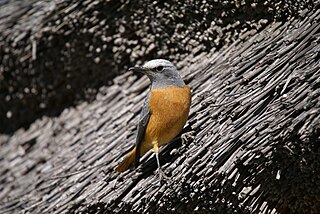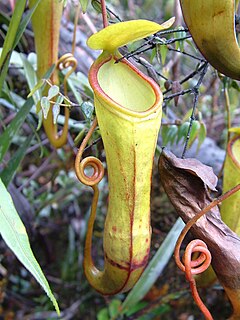
The rock thrushes, Monticola, are a genus of chats, medium-sized mostly insectivorous or omnivorous songbirds. All are Old World birds, and most are associated with mountainous regions.

The common rock thrush, formerly rufous-tailed rock thrush or rock thrush, is a chat belonging to the family Muscicapidae. It was formerly placed in the family Turdidae. The scientific name is from Latin. Monticola is from mons, montis "mountain", and colere, "to dwell", and saxatilis means "rock-frequenting", from saxum, "stone".

The blue rock thrush is a species of chat. This thrush-like Old World flycatcher was formerly placed in the family Turdidae. It breeds in southern Europe, northwest Africa, and from central Asia to northern China and Malaysia. The blue rock thrush is the official national bird of Malta and was shown on the Lm 1 coins that were part of the country's former currency.

Western white pine also called silver pine, and California mountain pine, in the family Pinaceae, is a species of pine that occurs in the mountains of the western United States and Canada, specifically the Sierra Nevada, the Cascade Range, the Coast Range, and the northern Rocky Mountains. The tree extends down to sea level in many areas, particularly in Oregon and Washington. It is the state tree of Idaho, and is sometimes known as the Idaho pine.
Amolops monticola is a species of frog found in Asia. The species range includes the northeastern parts of India, Nepal and Tibet, China. The primary habitat is temperate forests and wetlands, especially shaded stream rapids, at elevations of 850–2,350m. This frog lays eggs in stone crevices along the edges of streams, and on aquatic plants. It is not considered threatened by the IUCN.
Callitris monticola, or dwarf cypress, is a species of conifer in the family Cupressaceae. It shares the common name with several other plants. It is found only in Australia. It is threatened by habitat loss.

Juniperus monticola, or Mountain juniper, is a species of conifer in the family Cupressaceae. It is found only in Mexico.

The Sunda shrew is a species of mammal in the family Soricidae found in Indonesia and Malaysia.
Vitis monticola, commonly known as mountain grape, or sweet mountain grape, is a North American species of wild grape native to Texas. It is important to grape growers for its resistance to drought; a quality exploited both genetically in hybridization, and in grafting.

Nepenthes monticola is a tropical pitcher plant known from a number of mountains in the west central highlands of West Papua, New Guinea, where it grows at elevations of 1400–2620 m above sea level. Prior to its description as a species in 2011, N. monticola was lumped with the closely related N. lamii.
Astathini is a tribe of longhorn beetles of the Lamiinae subfamily. It was described by Thomson in 1864.
Momisis is a genus of longhorn beetles of the subfamily Lamiinae.
Momisis aegrota is a species of beetle in the family Cerambycidae. It was described by Pascoe in 1867. It is known from Indonesia.
Momisis borneana is a species of beetle in the family Cerambycidae. It was described by Vives and Heffern in 2012.
Momisis longicornis is a species of beetle in the family Cerambycidae. It was described by Pic in 1912. It is known from China, Vietnam, Laos and Borneo.
Momisis longzhouensis is a species of beetle in the family Cerambycidae. It was described by Hua in 1982. It is known from China.
Momisis melanura is a species of beetle in the family Cerambycidae. It was described by Gahan in 1901. It is known from Australia.
Momisis nicobarica is a species of beetle in the family Cerambycidae. It was described by Gardner in 1936. It is known from the Nicobar Islands.
Momisis singularis is a species of beetle in the family Cerambycidae. It was described by Ritsema in 1888. It is known from Sumatra.
Momisis submonticola is a species of beetle in the family Cerambycidae. It was described by Breuning in 1968. It is known from China and Laos.









